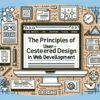Mobile-First Design: Adapting User Experience for Smaller Screens

Embracing Mobile-First Design for Superior User Experience
In today’s fast-paced digital landscape, mobile devices dominate internet consumption. This shift necessitates a design approach that prioritizes mobile experiences, ensuring content is accessible, engaging, and user-friendly on smaller screens. Mobile-First Design is not just a trend but an essential strategy in developing websites and applications that cater to the majority of users. This article delves into the fundamentals of Mobile-First Design and offers practical tips for adapting user experience (UX) for smaller screens, ensuring your projects align with the needs of the modern user.
Understanding Mobile-First Design
Mobile-First Design is a design strategy that starts the product design from the mobile end, which has more restrictions, then expands its features to create a tablet or desktop version. This approach differs from the traditional method of designing for desktop first and then adapting for smaller screens. The core advantage of Mobile-First Design is its emphasis on prioritizing the content and functionalities that are essential for mobile users, thereby enhancing overall user experience across all devices.
Key Principles of Mobile-First Design
<h4>H3: Simplify Your DesignThe limited real estate of mobile screens demands a minimalist approach to design. Focus on simplifying your layout, using only necessary elements that deliver value to the user. This not only makes your website or application faster but also easier to navigate, significantly improving the mobile user experience.
<h4>H3: Enhance UsabilityEnhancing usability on mobile devices involves designing with touch controls in mind. Larger, easy-to-tap buttons, and touch-friendly interfaces ensure smoother navigation and interaction, reducing frustration and improving overall user satisfaction.
<h4>H3: Optimize Content for MobileAdapting content for mobile screens is crucial. This includes breaking up large blocks of text into more digestible chunks, using scalable images that load quickly, and ensuring all multimedia is optimized for mobile consumption. Remember, mobile users are often on-the-go, so content needs to be easily consumable.
Best Practices for Mobile-First Design
<h4>H3: Responsive Design TechniquesResponsive design is foundational to Mobile-First Design, ensuring that your website or application adapts to any screen size seamlessly. Utilizing flexible grid layouts, media queries, and scalable assets are crucial techniques in achieving an adaptable design.
<h4>H3: Prioritize Speed and PerformanceMobile users expect quick, efficient access to information. Optimize loading times by compressing images, leveraging browser caching, and minimizing the use of heavy scripts that can slow down your site. A responsive, fast-loading site significantly improves the user experience, keeping users engaged.
<h4>H3: Test, Test, TestTesting is vital to ensure your design works well across different devices. Use a combination of emulators and real devices to test usability, load times, and overall user experience. Continuous testing and iteration based on user feedback help refine and improve the mobile experience.
Conclusion
Mobile-First Design is an indispensable approach in today’s digital age, where more users access the internet via mobile devices than ever before. By simplifying designs, enhancing usability, and optimizing content for mobile, developers can create engaging, user-friendly experiences that meet the expectations of modern users. Embracing these principles and best practices of Mobile-First Design not only improves the usability of your projects on smaller screens but also sets a solid foundation for a comprehensive, user-centered design strategy.


